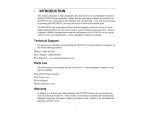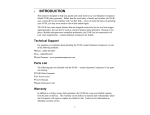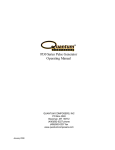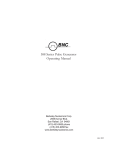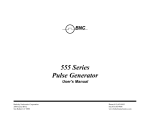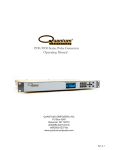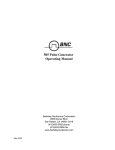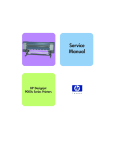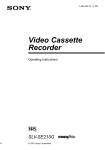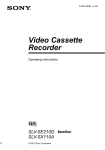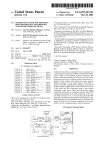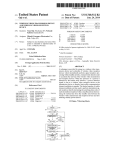Download Quantum Composers Sapphire 9200 Series Specifications
Transcript
Sapphire 9200 Series Pulse Generator Operating Manual Quantum Composers, Inc. P.O. Box 4248 Bozeman, MT 59772 1.800.510.6530 www.QuantumComposers.com [email protected] 9200 Manual Version 1.2 | Quantum Composers Page 1 Contents 1. INTRODUCTION ........................................................................................................................................................ 4 TECHNICAL SUPPORT .................................................................................................................................................................. 4 WARRANTY .............................................................................................................................................................................. 4 PACKAGE CONTENTS .................................................................................................................................................................. 4 2. SAFETY ISSUES .......................................................................................................................................................... 5 3. FRONT & BACK PANEL OVERVIEW ............................................................................................................................ 6 FRONT PANEL ........................................................................................................................................................................... 6 Indicators .......................................................................................................................................................................... 6 Run/Stop/Power Button ................................................................................................................................................... 6 BACK PANEL ............................................................................................................................................................................. 7 Indicators .......................................................................................................................................................................... 7 BNC Output Connectors .................................................................................................................................................... 7 USB ................................................................................................................................................................................... 7 Run/Stop/Power Button ................................................................................................................................................... 7 4. PULSE CONCEPTS AND PULSE GENERATOR OPERATIONS ......................................................................................... 8 COUNTER ARCHITECTURE OVERVIEW............................................................................................................................................. 8 SYSTEM TIMER FUNCTIONS.......................................................................................................................................................... 8 CHANNEL TIMER FUNCTIONS ....................................................................................................................................................... 9 DIGITAL OUTPUT MULTIPLEXER .................................................................................................................................................... 9 DEPENDENT & INDEPENDENT TIMING EVENTS (SYNC FUNCTION) ....................................................................................................... 9 NAVIGATING THE 9200 ............................................................................................................................................................ 10 ENABLING SYSTEM OUTPUT ....................................................................................................................................................... 10 5. 9200 SETUP ............................................................................................................................................................. 11 OVERVIEW ............................................................................................................................................................................. 11 POWER .................................................................................................................................................................................. 11 COMMUNICATION ................................................................................................................................................................... 11 USB ..................................................................................................................................................................................... 11 DRIVER INSTALLATION (WINDOWS XP) ........................................................................................................................................ 12 DRIVER INSTALLATION (WINDOWS 7) .......................................................................................................................................... 12 6. 9200 APPLICATION ................................................................................................................................................. 13 9200 APPLICATION OVERVIEW .................................................................................................................................................. 13 BASIC OPERATION ................................................................................................................................................................... 14 System Section................................................................................................................................................................ 14 Channels Section ............................................................................................................................................................ 15 COMMAND TERMINAL .............................................................................................................................................................. 16 PARAMETER STORAGE .............................................................................................................................................................. 17 Saving Custom Settings to a Bin ..................................................................................................................................... 17 Recalling Custom Settings from a Bin ............................................................................................................................. 18 9200 APPLICATION EXAMPLE .................................................................................................................................................... 19 7. OPERATING THE 9200 ............................................................................................................................................. 20 NORMAL INTERNAL RATE GENERATOR OPERATION ........................................................................................................................ 20 Page 2 9200 Manual Version 1.2 | Quantum Composers Continuous Mode ........................................................................................................................................................... 20 Single Shot Mode ............................................................................................................................................................ 21 System Burst Mode Function .......................................................................................................................................... 21 System Duty Cycle Function ............................................................................................................................................ 21 CHANNEL TIMER OVERVIEW ...................................................................................................................................................... 22 Channel Normal Function ............................................................................................................................................... 22 Channel Single Shot Function ......................................................................................................................................... 23 Channel Burst Mode ....................................................................................................................................................... 23 Channel Duty Cycle Mode ............................................................................................................................................... 23 EXTERNAL INPUT OVERVIEW ...................................................................................................................................................... 24 Generate a Pulse on Every Trigger Input ........................................................................................................................ 24 Using the External Gate to Control the System .............................................................................................................. 25 Using the External Gate to Control the Channel............................................................................................................. 25 OUTPUT EXAMPLES.................................................................................................................................................................. 27 8. PROGRAMMING THE 9200 ...................................................................................................................................... 28 PERSONAL COMPUTER TO 9200 COMMUNICATION ....................................................................................................................... 28 USB Interface Overview .................................................................................................................................................. 28 PROGRAMMING COMMAND TYPES AND FORMAT .......................................................................................................................... 28 Line Termination ............................................................................................................................................................ 29 IEEE 488.2 Common Command Format ......................................................................................................................... 29 SCPI Command Keywords ............................................................................................................................................... 29 SCPI Command Format ................................................................................................................................................... 30 SCPI Keyword Separator ................................................................................................................................................. 30 SCPI Optional Keywords ................................................................................................................................................. 30 SCPI Parameter Types ..................................................................................................................................................... 31 Error Codes ..................................................................................................................................................................... 31 Programming Examples ................................................................................................................................................. 31 9200 SCPI COMMAND SUMMARY ............................................................................................................................................. 33 IEEE 488.2 COMMON COMMANDS ........................................................................................................................................... 37 9. APPENDIX A – SPECIFICATIONS ............................................................................................................................... 38 9200 SPECIFICATIONS .............................................................................................................................................................. 38 10. APPENDIX B – BLUETOOTH OPTION .................................................................................................................... 41 OVERVIEW ............................................................................................................................................................................. 41 POWER .................................................................................................................................................................................. 41 INITIALIZATION & CONNECTIVITY ................................................................................................................................................ 41 11. APPENDIX C – SAFETY SYMBOLS ......................................................................................................................... 43 SAFETY MARKING SYMBOLS....................................................................................................................................................... 43 12. APPENDIX D – CE DECLARATION OF CONFORMITY ........................................................................................... 45 9200 Manual Version 1.2 | Quantum Composers Page 3 1. Introduction This manual is a reference designed to familiarize you with the Quantum Composers 9200 series pulse generator and is arranged so that you can easily find the information you’re looking for. Generally, each topic has its own section and no section assumes that yo u’ve read anything else in the manual. Technical Support For questions or comments about operating the 9200 our technical staff can be reached via one of the following methods: Phone - (406) 582-0227 Fax - (406) 582-0237 Internet - www.quantumcomposers.com Warranty In addition to a 30-day money back guarantee, the 9200 has a two-year limited warranty from the date of delivery. This warranty covers defects in materials and workmanship. Quantum Composers will repair or replace any defective unit. Contact us for information on obtaining warranty service. Package Contents The box you receive should contain the following: 9200 Pulse Generator User’s Manual, Drivers, & 9200 application on Disc USB Cord Contact Quantum Composers 1 (406) 582-0227 if any parts are missing. Updated CD contents and/or support are available from the web site at: www.quantumcomposers.com Page 4 9200 Manual Version 1.2 | Quantum Composers 2. Safety Issues Normal use of test equipment presents a certain amount of danger due to electrical shock because it may be necessary for testing to be performed where voltage is exposed. An electrical shock causing 10 milliamps of current to pass through the heart will stop most human heartbeats. Voltage as low as 35 VDC or 35 V RMS AC should be considered dangerous and hazardous, as it can produce a lethal current under certain conditions. Higher voltages pose an even greater threat because such voltage can easily produce a lethal current. Your normal work habits should include all accepted practices that will prevent contact with exposed high voltage and steer current away from your heart in case of accidental contact with a high voltage. You will significantly reduce the risk factor if you know and observe the following safety precautions: If possible, familiarize yourself with the equipment being tested and the location of its high-voltage points. However, remember that high voltage may appear at unexpected points in defective equipment. Do not expose high voltage needlessly. Remove housing and covers only when necessary. Turn off equipment while making test connections in high - voltage circuits. Discharge high-voltage capacitors after shutting down power. When testing AC powered equipment, remember that AC line voltage is usually present on power input circuits, such as the on-off switch, fuses, power transformer, etc. Use an insulated floor material or a large, insulated floor mat to stand on, and an insulated work surface on which to place equipment. Make certain such surfaces are not damp or wet. Use the time-proven “one hand in the pocket” technique while handling an instrument probe. Be particularly careful to avoid contact with metal objects that could provide a good ground return path. Never work alone. Someone should always be nearby to render aid if necessary. Training in CPR first aid is highly recommended. 9200 Manual Version 1.2 | Quantum Composers Page 5 3. Front & Back Panel Overview Front Panel Indicators A total of up to 6 separate LED indicators are included on the front panel of the 9200. The following details the type of indication they represent. Quantum Logo Channel A-D Active Indicates the unit is powered on and system status. Indicates which channels are in the enabled state. Indicates the unit is armed and/or channels are actively pulsing (or waiting to be triggered). Run/Stop/Power Button The Run/Stop button serves the dual purpose of both powering on/off the unit as well as enabling/disabling the system output. It should be noted that only a short press is needed to both turn on and arm/disarm the unit. The button needs to be pressed and held for approximately 1 second in order to power off the unit. In the power off sequence the active settings are saved and reloaded when the unit is power back on. The following image represents the front panel of a 4 channel 9214. It should be noted that the 2 channel 9212 does not have channel C or D indicators. Figure 3.1 - 9214 Front Panel Page 6 9200 Manual Version 1.2 | Quantum Composers Back Panel Indicators A total of up to 8 separate LED indicators are included on the back panel of the 9200.The following further details the type of indication they represent. PWR Channel A-D Active Gate/Trig Indicates the unit is powered on. Indicates which channels are in the enabled state. Indicates the armed channels are actively pulsing (or waiting to be triggered). Indicates which mode the external input is in. If neither is illuminated, the unit is in internally triggered mode. BNC Output Connectors Standard BNC connectors are found on the back panel which output the pulses for their respective channel. USB A “Standard B” female type USB connector is found on the back panel. This provides power to the unit as well as communication (on standard units). Run/Stop/Power Button The Run/Stop button serves the dual purpose of both powering on/off the unit as well as enabling/disabling the system output. It should be noted that only a short press is needed to both turn on and arm/disarm the unit. The button needs to be pressed and held for approximately 1 second in order to power off the unit. In the power off sequence the active settings are saved and reloaded when the unit is power back on. The following image represents the back panel of a 4 channel 9214. It should be noted that the 2 channel 9212 does not have channel C or D output BNC’s. Figure 3.2- 9214 Back Panel 9200 Manual Version 1.2 | Quantum Composers Page 7 4. Pulse Concepts and Pulse Generator Operations Counter Architecture Overview *Start source is: Run/Stop button/function in Internal Modes External input in External Trigger modes *TRG command via Serial access **Channels are armed by the Run/Stop function (external button or through 9200 application). In single shot and burst modes channels may be rearmed by pressing the RUN button again. System Timer Functions The System Timer functions as a non-retriggerable, multi-vibrator pulse generator. This means that once started, depending on the mode, the timer will produce pulses continuously. Before pulses can be generated, the timer must be armed and then receive a start pulse. Arming the counter is done by enabling the Run/Stop function by either the external button or through the 9200 application. With external trigger disabled, the Run/Stop function also generates the start command for the counter. With external trigger enabled, the external trigger provides the start pulse. In either case, once started, the counter operation is determined by the System Mode Generator. Standard modes include: Continuous Once started T 0 pulses are generated continuously. Single Shot Burst One T 0 pulse is generated for each start command. ‘N’ T 0 pulses are generated for each start command. Once started T 0 pulses cycle on and off continuously. Duty Cycle The T0 pulse is distributed to all of the start inputs of the Channel Timers and Mode Generators. Page 8 9200 Manual Version 1.2 | Quantum Composers Channel Timer Functions The Channel Timer functions as a non-retriggerable, delayed, one shot pulse generator. This means that the timer will only generate one delayed pulse for every start pulse received. Once the channel timer has started counting, additional start pulses will be ignored until the pulse has been completed (non-retriggerable). The start pulse for each channel is provided by the internal T 0 pulse generated by the internal system timer. Whether or not a pulse is generated for each T 0 pulse is determined by the Channel Mode Generator. Standard modes include: Normal A pulse is generated for each T 0 pulse. Single Shot One pulse is generated for the first T 0 pulse, after which the output is inhibited. Burst ‘N’ number of pulses are generated for each T 0 pulse, after which the output is inhibited. Duty Cycle ‘N’ number of pulses are produced, one for each T0 pulse, after which ‘M’ number of pulses will be inhibited, one for each T 0 pulse. The cycle is then repeated for each subsequent T0 pulse. A Different mode may be selected for each channel, allowing a wide variety of output combinations. Each output may also be independently disabled or gated (using the external gate input). Digital Output Multiplexer The outputs of each of the Channel Timers are routed to a set of multiplexers. This allows routing of any or all Channel Timers to any or all of the units’ outputs. In the normal mode of operation, the output of the n th Channel Timer is routed to the n th output connector. As an example, if a double pulse is required on Channel A, one can multiplex the Channel A timer with the Channel B timer, then adjust each timer to provide the necessary pulses. Only the timing parameters are multiplexed together, not the actual output amplitudes. Dependent & Independent Timing Events (Sync Function) The 9200 allows the user to control the relationship between the Channel Timers by setting the sync source for each timer. Independent events are all timed relative to the internal T 0 start pulse. Dependent events may be linked together by setting the sync source to the controlling event. This allows the instrument to match the timed events and adjustments can be made in one event without detuning the timing between it and the dependent event. 9200 Manual Version 1.2 | Quantum Composers Page 9 Navigating the 9200 Primary control of the 9200 is carried out either through the 9200 application (see 9200 application Menus) or through unit specific commands using a terminal program via USB (see Programming the 9200). Communication through Bluetooth is also available as an upgrade which will allow the same user interfaces as USB. The Run/Stop buttons found on either side of the 9200 serve the purpose of both power on/off as well as enablin g/disabling the system output. Enabling System Output The Run/Stop button found on both the front and back panel of the 9200 is used to arm the system. With external trigger disabled, the button will arm and start pulse output. With external trigger enabled, the button will arm the pulse generator. Pulse outputs then starts after the first valid trigger input. Pressing the Run/Stop button a second time disables the pulse generator. Page 10 9200 Manual Version 1.2 | Quantum Composers 5. 9200 Setup Overview The 9200 can easily be interfaced by means of the included 9200 application. On standard models, a USB cable and a port with USB 2.0 capabilities or greater (recommended) are required to communicate with the unit. Bluetooth is available as an option if wireless communication is required. If the equipment is used in a manner not specified by the manufacturer, the protection provided by the equipment may be impaired. Power The 9200 requires a +5VDC±250mV (≥470mA) power supply to operate. When the power is supplied from a computer device, it is recommended that a USB 2.0 port (or greater) is used. The unit may also be powered directly from a 5VDC USB DC wall-mount supply ( ≥470mA). The current draw is highly dependent on the external loads. If all loads are high impedance, the unit will require far less current to operate correctly. It should be noted that if 9200 consumes ≥500mA, the internal current sense circuit will cause the unit to go into a latched state, which is depicted by the flashing LED’s on the Quantum logo. In this state, all outputs will be inactive. In order to clear this state, the 9200 must be power cycled. In order to further avoid this state, it is highly recommended that loads connected to any of the outputs be ≥50 ohms. If the 9200 is powered from a wall-mount supply, communication takes place only through Bluetooth (optional upgrade). The USB cable should be plugged into the rear panel of the unit that is labeled USB. The multi-functional power button, labeled “Run/Stop,” located on both front and back of the unit will turn on the 9200 when pressed once. If a USB DC wallmount supply is chosen to be used, it is recommended that the AC Mains Socket-Outlet be easily accessible so that the external power supply can be easily removed from the AC Mains Socket Outlet. Communication The 9200 provides a standard USB connection for remote communications. An optional Bluetooth feature is also available. USB When the 9200 is connected to a remote computer via the USB connection, the computer will recognize the unit as a “QC-PG”. Drivers will need to be installed for the remote computer to interface to the 9200. Drivers are included on the provided CD. Once the drivers have been installed, the 9200 will show up in the device manager as a USB to Serial Port Adapter. The 9200 can then be communicated with by either the included 9200 application or by using any generic communication terminal program. The unit is baud rate independent, so any speed can be selected. Typically a rate of 115,200bps can be used. 9200 Manual Version 1.2 | Quantum Composers Page 11 Driver Installation (Windows XP) 1. Plug the 9200 into the computer using a USB cable. Make sure the unit is powered on. 2. The computer will display a message indicating it has found new hardware: “QC-PG”. 3. The new hardware wizard will launch. Check the “Install from a list or specific location” option and click next. 4. Select “Search for the best driver in these locations” and check the option to “Include this location in the search”. Click the browse button and locate the folder on the CD where the 9200 drivers are located. Click next. 5. A message window will launch asking if you want to continue installing this driver. Select the “Continue Anyway” button. 6. It should now indicate that it is installing a driver for a “QC-PG USB Communications Port”. 7. Once the process is finished, a message will indicate that the drivers have been successfully installed. 8. You can now communicate with the 9200 using either the included 9200 application or by using any generic communication terminal program. You can view the Com Port number assigned to the 9200 in your computers device manager under Ports. Driver Installation (Windows 7) 1. Plug the 9200 into the computer using a USB cable. Make sure the unit is powered on. 2. A message will pop up on the computer indicating it has found new hardware and is installing device driver software. 3. A message will indicate that the device drivers have not been successfully installed. The Action Center may then launch with a list of options. Close the Action Cent er and do not launch any of the actions. 4. Go to your computers device manager. This can be done by one of two ways. a) Right click on the desktop “Computer” icon and select properties. Select Device Manager on the left toolbar. b) Navigate to Control Panel and then Device Manager. 5. In Device Manager you should see a device under the Other Devices called the QC-PG. There will be a yellow exclamation point next to it. 6. Right click on the QC-PG and select update driver software. 7. Select “Browse My Computer” for driver software and browse to the location of the USB drivers for the 9200. The location is typically found on the software CD. It will contain a file called “9200cdc.inf”. Select the folder in which the file resides, not the file itself. Click next. 8. Windows will then indicate a warning window that the drivers are not verified. Select “Install this driver software anyway”. 9. A message will then indicate that the drivers have been successfully updated and a QC9200 USB Communication Port is now available. 10. You can now communicate with the 9200 using either the included 9200 application or by using any generic communication terminal program. You can view the Com Port number assigned to the 9200 in your computers device manager under Ports. Page 12 9200 Manual Version 1.2 | Quantum Composers 6. 9200 Application 9200 Application Overview Aside from using the SCPI command protocol, the included software application is the primary means of communication with the 9200. This application allows simple control of the 9200 unit via the USB or optional Bluetooth communications port. To run the software, simply double click on the application which can be found on the included CD. No installation is required. The software can also be copied to your computer and run from any location. The following screenshot (Figure 6.1) shows the 9200 application and all of the corresponding default parameters: Figure 6.1 –9200 Application 9200 Manual Version 1.2 | Quantum Composers Page 13 Basic Operation The following steps must be carried out before communication with the 9200 may take place: Ensure that the proper drivers have already been installed on the remote computer. These drivers will need to be installed for the remote computer to interface to the 9200. Reference the “9200 Setup USB” section for more information on installing the proper drivers. Open the 9200 application by double clicking on the application which can be found on the included CD. Once the 9200 application recognizes the COM Port the 9200 is attached to, a connection will be established, and communication may now be carried out. System Section The System Section of the 9200 application only affects the 9200’s system parameters. As shown below in Figure 6.2, the following system parameters may be altered: Figure 6.2 –9200 Application: System Parameters Pulse Mode: Changes the system’s output mode to Continuous, Single Shot, Burst, or Duty Cycle. Period: Sets the System’s T 0 period. Valid inputs are 200ns–1000s set in 10ns increments. Duty Cycle: If Duty Cycle has been selected in the System’s Pulse Mode, the unit will generate a continuous pulse stream in which outputs will be On for “N” pulses and Off for “M” pulses. One may alters the “N” (On) and “M” (Off) parameters: On Counts (“N”): Positive integer value which designates the number of pulses to produce during the “On Cycle.” Valid inputs are 1-1,000,000. Off Counts (“M”): Positive integer value which designates the number of pulses to suppress during the “Off Cycle.” Valid inputs are 1 -1,000,000. Burst Count: If Burst mode has been selected in the System’s Pulse Mode, the Burst Counts positive integer input selects the number of T 0 pulses generated once the Run/Stop button has been pressed. Valid inputs are 1-1,000,000. Run: Enables or disables the output for all channels. This command is the same as pressing the Run/Stop button on either the front or back panel. Page 14 9200 Manual Version 1.2 | Quantum Composers Auto Start: Enables or disables the Auto Start function. If enabled, the unit will start pulsing immediately upon power-up or be in an armed state if in external mode. External Trigger/Gate: Selects the system’s External Mode to be Disabled, Triggered, or Gated. If either Triggered or Gated is selected, the following sub -parameters may be set. o Threshold (V): Sets the trigger threshold Voltage in 10mV increments. Typically this value should be set to 50% of the incoming trigger voltage for optimum trigger response. Valid threshold values are 0.20V-15V. The unit can handle up to a 30V external input. o Gate Polarity: If the External Mode has been set to Gated, alter the Gate Polarity to the required polarity. Active low or active high are the available modes. o Trigger Edge: If the External Mode has been set to Triggered, alter the Trigger Edge to the required transition. Rising or falling edge are the available modes. Channels Section The Channels Section of the 9200 application only affects the 9200’s channel parameters. Complex pulse trains can be created by combining various system and channel modes. As shown below in Figure 6.3, the following channel parameters may be altered: Figure 6.3 –9200 Application: Channel Parameters Channel Selection: Select the proper Channel tab in order to further edit the parameters on the corresponding channel. Enabled: Enables and Disables the output for the selected channel. Delay: Sets the delay from the timing reference to when the pulse is created. Valid input is ±1000s with 10ns increments. Note: negative delays are only applicable if you are referenced to a channel that has a positive delay. Width: Sets the pulse width for the selected channel. Valid input is 10ns – 1000s with 10ns increments. Amplitude: Allows the user to select the voltage amplitude of the output. Valid values are 3.3V – 5V with 20mV increments. 9200 Manual Version 1.2 | Quantum Composers Page 15 Channel Mode: Changes the Channel Mode to Normal, Single Shot, Burst, or Duty Cycle. o Normal: Channel will produce pulses as long as a T 0 is present (mimics System Pulse Mode) o Duty Cycle: If Duty Cycle has been selected in the Channels section, the unit will generate a continuous pulse stream in which outputs will be On for “N” pulses and Off for “M” pulses. One may alters the “N” (On) and “M” (Off) parameters: On Counts (“N”): Positive integer value which designates the number of pulses to produce during the “On Cycle.” Valid inputs are 1-100,000. Off Counts (“M”): Positive integer value which designates the number of pulses to suppress during the “Off Cycle.” Valid inputs are 1 -100,000. o Burst Counts: Selects the number of pulses to output with each input clock pulse. Valid input is 1-1,000,000. o Single Shot: Will produce one pulse each time the channel is armed. Sync Source: Selects the timing reference for the selected channel. Each channel may be set to sync to T 0 or may be set to sync to a different channel. It should be noted that if a channel is set to sync to a separate channel a negative delay may be used as long as that delay does not require the pulse be produced before the T 0 pulse is produced. For example: the value of (T0 + Sync source delay + channel delay) must be greater than or equal to 0. Wait Counts: Selects how many T 0 pulses to wait until the channel outputs its first pulse. Valid input is 1-100,000. Polarity: Selects the Channel’s Polarity. Normal is active HIGH, Inverted is active LOW. Mux: The outputs of each of the Channel Timers are routed to a set of multiplexers. This allows routing of any or all Channel Timers to any or all of the units’ outputs. In the normal mode of operation, the output of the n th Channel Timer is routed to the nth output connector. As an example, if a double pulse is required on Channel A, one can mul tiplex the Channel A timer with the Channel B timer, then adjust each timer to provide the necessary pulses. Only the timing parameters are multiplexed together, not the actual output amplitudes. Gate Mode: Selection determines which active state will gate the selected channel output. Command Terminal The Command Terminal Section on the 9200 application shown below (Figure 6.4) allows the user to manually input SCPI based commands in order to alter parameters on the 9200. See “Programming the 9200” for more information on sending and formatting commands. It should also be noted that whenever a selection is made on the 9200 application, the corresponding SCPI based command will automatically be sent through the Command Terminal to the device. Figure 6.4 –9200 Application: Command Terminal Page 16 9200 Manual Version 1.2 | Quantum Composers Parameter Storage Saving Custom Settings to a Bin The 9200 series has the capability to save up to 6 custom user setups. Once all the custom user settings are ready to be saved to one of six bins, click “Storage”, “Save To Bin”, followed by selecting the bin number to save the custom settings to. Figure 6.5 represents the saving process: Figure 6.5 –9200 Application: Recalling From Bin 9200 Manual Version 1.2 | Quantum Composers Page 17 Recalling Custom Settings from a Bin The 9200 series has the capability to recall any of the 6 custom user setups. If any of the previously saved presets are to be recalled, click “Storage”, “Restore From Bin”, followed by selecting the bin number to recall. Figure 6.6 represents the recalling process: *Note: Selecting Default 0 will set the 9200 to factory default settings. Figure 6.6 –9200 Application: Recalling From Bin Page 18 9200 Manual Version 1.2 | Quantum Composers 9200 Application Example This example will demonstrate the proper 9200 application settings for a specific scenario. The example will show how to output a single pulse on Channel-A upon receiving the rising edge of every external trigger signal at 5V. The output will have an amplitude of 4V, pulse width of 10us, and no channel delay present. Figure 6.7 –9200 application: Example 9200 Manual Version 1.2 | Quantum Composers Page 19 7. Operating the 9200 Normal Internal Rate Generator Operation The 9200 has a complete set of functions providing a number of modes of operation for the internal or “System” rate generator (T 0). Most of these functions can be ignored if a simple continuous stream of pluses is required. Starting from the default settings, which can be restored by recalling configuration 0, the following parameters need to be set in the 9200 application: Pulse Width, Delay T0 Period Enter the required pulse width and delay found in the Channel section. Repeat for each output channel. Set the desired pulse Period found in the System section. *Note: In general the pulse delay + the pulse width + 75 ns (for a hardware reset for any channel) must be less than the T 0 period. Enable Start Stop Enable the corresponding channels by clicking “Enabled” in the Channel section. Press the unit’s Run/Stop button to start generating pulses Press the unit’s Run/Stop button once again to stop generating pulses. Continuous Mode Pressing the unit’s Run/Stop button starts and stops a continuous pulse stream at the rate specified by the Period parameter. This corresponds to the default output mode for most pulse generators. To generate a continuous stream of pulses, set the following parameters in the 9200 application: Within the System section: o Select Continuous mode. o Set the desired pulse Period. Within the Channel section: o Enter the required pulse width and delay. Repeat for each output channel. o Enable the corresponding channels by clicking “Enabled” in the 9200 application. Pressing the unit’s Run/Stop button will now generate a stream of T0 pulses at a rate specified by the Period parameter. Page 20 9200 Manual Version 1.2 | Quantum Composers Single Shot Mode Pressing the unit’s Run/Stop button generates a single pulse with every press. Set the following parameters in the 9200 application: Within the System section: o Select Single Shot mode. Within the Channel section: o Set channel mode to Normal. o Enter the required pulse width and delay. Repeat for each output channel. o Enable the corresponding channels by clicking “Enabled” in the 9200 application. Pressing the unit’s Run/Stop button will now generate one pulse out of every enabled channel. System Burst Mode Function The Run/Stop button generates a stream of ‘N’ T 0 pulses, where the ‘N’ is specified by the Burst parameter. The rate is specified by the Period parameter. Pressing the Run/Stop button while the burst is in process will stop the output. After the burst has been completed, Pressing the Run/Stop button will generate another burst of pulses. To generate a burst of pulses set the following parameters in the 9200 application: Within the System section: o Select mode to be Burst. o Set the Burst Count parameter field to produce the number of pulses desired o Set the desired Period. Within the Channel section: o Set channel mode to Normal. o Enter the required pulse width and delay. Repeat for each output channel. o Enable the corresponding channels by clicking “Enabled” in the 9200 application. Pressing the unit’s Run/Stop button will now generate the predefined burst of pulses out of every enabled channel. System Duty Cycle Function The Run/Stop button starts a continuous stream of T 0 pulses, which repeats for ‘N’ pulses On and ‘M’ pulses Off, where ‘N’ and ‘M’ are specified by the On/Off parameters respecti vely. The rate at which the pulses are generated is controlled by the Period parameter. To generate a stream of pulses which will repeat for ‘N’ pulses On and ‘M’ pulses, set the following parameters in the 9200 application: 9200 Manual Version 1.2 | Quantum Composers Page 21 Within the System section: o Set the mode to Duty Cycle. o Set the On parameter to the number of pulses to produce during the on cycle (‘N’). o Set the Off parameter to the number of pulses to suppress during the off cycle (‘M’). o Set the desired Period. Within the Channel section: o Set channel mode to Normal. o Set the Sync Source to T 0 in each respective channel tab . o Enter the required pulse width and delay. Repeat for each output channel. o Enable the corresponding channels by clicking “Enabled” in the 9200 application. Pressing the unit’s Run/Stop button will now generate duty cycle pulses out of every enabled channel. Channel Timer Overview The output of each channel is controlled by two timers to generate the pulse width and the delay timing. All channels are simultaneously triggered, depending on the system mode, by the internal T 0 pulse, the external trigger, or a trigger provided by a user. A given channel may or may not generate a pulse depending on its own channel mode as described below. The examples below assume the system is set to continuous mode. Channel Normal Function The Normal mode mimics the system mode once the Run/Stop button is pressed. To use channel normal mode set the following parameters in the 9200 application: Within the System section: o Set the mode to Continuous. o Set the desired Period. Within the Channel section: o Set the mode to Normal. o Enter the required pulse width and delay. Repeat for each output channel. o Enable the corresponding channels by clicking “Enabled” in the 9200 application. Pressing the unit’s Run/Stop button will now generate a continuous stream of pulses. See “Output Examples” for a visual representation. Page 22 9200 Manual Version 1.2 | Quantum Composers Channel Single Shot Function The Single Shot mode generates a single pulse every time the unit is placed into active mode. To use the channels’ single shot mode set the following parameters in the 9200 application: Within the System section: o Set the mode to Continuous. o Set the desired Period (regulates rate of single shots) Within the Channel section: o Set the mode to Single Shot. o Enter the required pulse width and delay. Repeat for each output channel. o Enable the corresponding channels by clicking “Enabled” in the 9200 application. Pressing the unit’s Run/Stop button will place the unit into active mode and generate a single pulse on the enabled channels. Pressing the unit’s Run/Stop button again will take the unit out of the active state (which will not produce a pulse). Continue this process for additional single pulses. See “Output Examples” for a visual representation. Channel Burst Mode The burst mode generates a burst of pulses every time the unit is placed into active mode. To use the channels’ burst mode set the following parameters in the 9200 application: Within the System section: o Set the mode to Continuous. o Set the desired Period. Within the Channel section: o Set the mode to Burst. o Set the Burst parameter to the number of pulses to produce during the on cycle (‘N’). o Enter the required pulse width and delay. Repeat for each output channel. o Enable the corresponding channels by clicking “Enabled” in the 9200 application. Pressing the unit’s Run/Stop button will place the unit into active mode and generate a burst of pulses on the enabled channels. Pressing the unit’s Run/Stop button again will take the unit out of the active state (which will not produce a burst). Continue this process for additional bursts. See “Output Examples” for a visual representation. Channel Duty Cycle Mode The channel duty cycle mode will generate a stream of pulses on the channel level which will repeat on for ‘N’ pulses and off or ‘M’ pulses. To generate the stated sequence of pulses set the following parameters in the 9200 application: Within the System section: o Set the mode to Continuous. o Set the desired Period. 9200 Manual Version 1.2 | Quantum Composers Page 23 Within the Channel section: o Set the On parameter to the number of pulses to produce during the on cycle (‘N’). o Set the Off parameter to the number of pulses to suppress during the off cycle (‘M’). o Enter the required pulse width and delay. Repeat for each output channel. o Enable the corresponding channels by clicking “Enabled” in the 9200 application. Pressing the unit’s Run/Stop button will place the unit into active mode and generate a pulse train based on the duty cycle settings. Pressing the unit’s Run/Stop button again will take the unit out of the active state (which will not produce pulses). Continue this process for additional duty cycle pulse trains. See “Output Examples” for a visual representation. *Note: If a divide-by-’N’ function is desired, the duty cycle mode can be used. The duty cycle mode is a more general case of this operation. To reproduce the divide-by-’N’ function set the on cycle to 1 and set the off cycle to ‘N’-1, where ‘N’ is the divide by factor. External Input Overview The external Trigger/Gate input may be used to trigger the unit or gate the system/channel timers. When used in trigger mode, the external input acts as a system start pulse. Conversely, when used in gate mode, the external input acts in a pulse inhibiting fashion. It should be noted that when the 9200 is in external trigger mode, a single pulse will be produced on each active channel for each external input trigger signal when in system Single Shot mode or system Continuous mode. If the unit is in system Burst mode, the unit will produce a single pulse on each active channel for each external input trigger signal only until the number of specified burst counts is reached, at which time the unit will become disarmed. If the unit is in system Duty Cycle mode, a single pulse will be produced on each active channel for each external input trigger signal for the set “N” number of on counts but will ignore the set “M” number of off counts. Generate a Pulse on Every Trigger Input To generate a single pulse on every trigger input set the following parameters in the 9200 application: Within the System section: o Set the mode to Single Shot mode. o Set the desired Period. o Select the Triggered mode. o Set the trigger threshold level to ~50% of the incoming signal. o Select which edge (i.e. rising or falling) to trigger on. Page 24 9200 Manual Version 1.2 | Quantum Composers Within the Channel section: o Set the mode to Normal. o Enter the required pulse width and delay. Repeat for each output channel. o Enable the corresponding channels by clicking “Enabled” in the 9200 application. Pressing the unit’s Run/Stop button will arm the unit. Once the unit is armed, it will generate a T0 pulse for every external trigger received. Pressing the unit’s Run/Stop button or clicking the 9200 application’s Run/Stop again will disarm the unit. This mode corresponds to the normal external mode found on most other pulse generators. See “Output Examples” for a visual representation. Using the External Gate to Control the System The external input configured in System Gate mode may be used to control the output of the unit. To gate the internal system timer with an external source set the following parameters on the 9200 application: Within the System section: o Set the desired System mode. o Set the desired Period. o Chose *Gated mode. o Choose the proper *Gated polarity (High/ Low). o Set the threshold level to ~50% of the incoming gate signal. Within the Channels section: o Enter the required pulse width and delay. Repeat for each output channel. o Set the desired Channel Mode. Using the External Gate to Control the Channel The external input configured in Channel Gate mode may also be used to control the output of the unit. To gate the channel timers with an external source set the following parameters on the 9200 application: Within the System section: o Set the desired System mode. o Set the desired Period. o Set the threshold level to ~50% of the incoming gate signal. Within the Channels section: o Enter the required pulse width and delay. Repeat for each output channel. o Set the desired channel mode. o Set the proper **Gate Mode (Active High/Active Low) 9200 Manual Version 1.2 | Quantum Composers Page 25 * System gated mode (Pulse Inhibit mode) prevents the channel from being triggered by the channels’ trigger source. When in Pulse Inhibit mode, if a pulse has already started when the gate is active, the channel pulse will continue normal output; although, the output will not restart on the next trigger pulse until the gate signal is asserted again. See “Output Examples” for a visual representation. ** Channel gated mode (Output Inhibit mode) leaves the base triggering alone and enables/disables the output directly (i.e. the output will cease immediately upon the disabling of the external gate signal). See “Output Examples” for a visual representation. Pressing the unit’s Run/Stop will arm the unit. Once the unit is armed, it will begin generating pulses whenever the external trigger input is in the active state. When the gate is in the active state, the system timer is reset. Pressing the unit’s Run/Stop button again will disarm the unit. See “Output Examples” for a visual representation. Page 26 9200 Manual Version 1.2 | Quantum Composers Output Examples The following figure presents a graphical representation of the channel modes as well as the external trigger/gate functionality. It should be noted that following figure represents examples only as many parameters in each pulse train below have the potential to be modified. 9200 Manual Version 1.2 | Quantum Composers Page 27 8. Programming the 9200 Personal Computer to 9200 Communication The 9200 uses USB as the standard interface. Bluetooth is also available as an additional interface. All settings can be set and retrieved over either interface using a simple command language or with the included 9200 application. The command set is structured to be consistent with the Standard Commands for Programmable Instruments (SCPI). Although due to the high number of special features found in the 9200, many of the commands are not included in the specification. The syntax is the same for all interfaces. The average amount of time required to receive, process, and respond to a command at a baud rate of 115200 is 10ms. Sending commands faster than 10ms may cause the unit to not respond properly. It is advised to wait until a response from the previous command is received before sending the next command. USB Interface Overview The USB interface is standard on the 9200. Once the proper drivers have been installed, the 9200 will show up in the device manager as a USB to Serial Port Adapter. The 9200 can then be communicated with by either the included 9200 application or by using any generic communication terminal program. USB communication notes: The correct drivers must be installed on the personal computer before communication can be accomplished via USB. The unit is baud rate independent, so any speed can be selected. Typically a rate of 115,200bps can be used. It is recommended that USB 2.0 (or greater) specification is used. o The USB cable can be removed without “ejecting” the device in the operating system environment. Programming Command Types and Format The 9200 Pulse Generator uses two types of programming commands: IEEE 488.2 Common Commands and Standard Commands for Programmable Instruments (SCPI). The format is the same for all interfaces. The included 9200 application, HyperTerminal (in Windows), or any other generic terminal program may be used to interactively test the commands using the USB (or optional Bluetooth) interface. The format of each type is described in the following paragraphs. Page 28 9200 Manual Version 1.2 | Quantum Composers Line Termination The pulse generator uses text-style line terminations. When a command is sent to the unit, the firmware is programmed to read characters from a communication port until it reads the line termination sequence. The command string is parsed and executed after reading these characters. These characters are the “carriage return” and “linefeed”. They are ASCII character set values 13 and 10 respectively (hex 0x0D and 0x0A). All command strings need to have these characters appended. When the pulse generator responds to a command, whether it is a query or a parameter change, it also appends its return strings with these characters. Coded applications could use this behavior to know when to stop reading from the unit. However, if the “echo” parameter is enabled, there will be two sets of line terminators, one following the echoed command string, and one following the pulse generator’s response. The pulse generator responds to every communication string. If the communication string is a query, the unit responds with the queried response (or error code) followed by the line terminators. If the communication string is a parameter change, th e response is “ok” (or error code) followed by the line terminators. For this reason, it is not recommended that multiple commands be stacked together into single strings as is common with some other types of instruments. It is recommended that the coded application send a single command in a string and follow immediately by reading the response from the unit. Repeat this sequence for multiple commands. IEEE 488.2 Common Command Format The IEEE 488.2 Common Commands control and manage generic system functions such as reset, configuration storage and identification. Common commands always begin with the asterisk (*) character and may include parameters. The parameters are separated from the command pneumonic by a space character. For Example: *RST <cr><lf> *RCL 1 <cr><lf> *IDN? <cr><lf> SCPI Command Keywords The commands are shown as a mixture of upper and lower case letters. The upper case letters indicate the abbreviated spelling for the command. You may send either the abbreviated version or the entire keyword. Upper and/or lower case characters are acceptable. For example, if the command keyword is given as POLarity, then POL and POLARITY are both acceptable forms; truncated forms such as POLAR will generate an error; polarity, pol, and PolAriTy are all acceptable as the pulse generator is not case sensitive. *Note: The unit by default is not case sensitive. 9200 Manual Version 1.2 | Quantum Composers Page 29 SCPI Command Format SCPI commands control and set instrument specific functions such as setting the pulse width, delay, and period. SCPI commands have a hierarchical structure composed of functional elements that include a header or keywords separated with a colon, data parameters, and terminators. For example: SCPI Format :PULSE1:STATE ON <cr> <lf> :PULSe1:WIDTh 0.000120 <cr> <lf> :PULSe:POL NORMal <cr> <lf> Any parameter may be queried by sending the command with a question mark appended. For example: SCPI Query Format :PULSE1:STATE? <cr><lf> Will return :PULSE1:WIDTH? <cr><lf> Will return :PULSE1:POL? <cr><lf> Will return 1<cr><lf> 0.000120000 <cr><lf> NORM <cr><lf> SCPI Keyword Separator A colon (:) must always separate one keyword from the next lower-level keyword. A space must be used to separate the keyword header from the first parameter. SCPI Optional Keywords Optional keywords and/or parameters appear in square brackets ( [ ] ) in the command syntax. Note that the brackets are not part of the command and should not be sent to the pulse generator. When sending a second level key word without the optional keyword, the pulse generator assumes that you intend to use the optional keyword and responds as if it had been sent. SCPI Specific and Implied Channel Some commands, such as PULSe, allow specifying a channel with an optional numeric keyword suffix. The suffix will be shown in square brackets [ 1 / 2 ]. The brackets are not part of command and are not to be sent to the pulse generator. The numeric parameters correspond to the following channels: 0 = T 0, 1 = ChA, 2 = ChB, etc. Only one channel may be specified at a time. If you do not specify the channel number, the implied channel is specified by the :INSTrument:SELect command or the last referenced channel. After power-up or reset (*RST) the instrument will default to channel #1. Page 30 9200 Manual Version 1.2 | Quantum Composers SCPI Parameter Types The following parameter types are used: <Numeric Value> <Boolean Value> <Identifier> Accepts all commonly used decimal representation of numbers including optional signs, decimal points, and scientific notation: For Example: 123, 123e2, -123, -1.23e2, .123, 1.23e2, 1.2300E-01 Represents a single binary condition that is either true or false. True is represented by a 1 or ON; false is represented by a 0 or OFF. Queries return 1 or 0. Selects from a finite number of predefined strings. Error Codes The unit responds to all commands with either: ok <cr><lf> or ?’n ‘<cr><lf> Where ‘n’ is one of the following error codes: 1. 2. 3. 4. 5. 6. 7. 8. Incorrect prefix, i.e. no colon or * to start command. Missing command keyword. Invalid command keyword. Missing parameter. Invalid parameter. Query only, command needs a question mark. Invalid query, command does not have a query form. Command unavailable in current system state. Programming Examples Example 1) 20 ms pulse width, 2.3 ms delay, 10 Hz internal trigger, and continuous operation. :PULSE1:STATE ON <cr> <lf> :PULSE1:POL NORM <cr> <lf> :PULSE:WIDT 0.020 <cr> <lf> :PULSE1:DELAY 0.0023 <cr> <lf> :PULSE0:MODE NORM <cr> <lf> :PULSE0:PER 0.1 <cr> <lf> :PULSE0:EXT:MODE DIS <cr> <lf> 9200 Manual Version 1.2 | Quantum Composers enables channel A sets polarity to active high sets pulse width to 20 ms sets delay to 2.3 ms sets system mode to continuous sets period to 100 ms (10 Hz) disables the external trigger Page 31 To start the pulses use either of the following commands: :PULSE0:STATE ON <cr> <lf> :INST:STATE ON <cr> <lf> starts the pulses alternate form to start pulses Example 2) 25μs pulse width, 0 delay, external trigger, and one pulse for every trigger. :PULSE1:STATE ON <cr> <lf> :PULSE1:POL NORM <cr> <lf> :PULSE:WIDT 0.000025 <cr> <lf> :PULSE1:DELAY 0 <cr> <lf> :PULSE0:MODE SING <cr> <lf> :PULSE:EXT:MODE TRIG <cr> <lf> :PULS:EXT:LEV 2.5 <cr> <lf> :PULS:EXT:EDGE RIS <cr> <lf> enables channel A sets polarity to active high sets pulse width to 25μs sets delay to 0 sets system mode to single shot sets system to external trigger sets trigger level to 2.5 volts set to trigger on rising edge To arm the instrument in external gate mode, use either of the following commands: :PULSE0:STATE ON <cr> <lf> :INST:STATE ON <cr> <lf> Arms the instrument Alternate form if T0 is currently selected. A software generated external trigger can be generated by using the following command: *TRG <cr> <lf> Page 32 Generates a software external trigger 9200 Manual Version 1.2 | Quantum Composers 9200 SCPI Command Summary Command Keyword 1 Keyword 2 Keyword 3 Parameter Range :INSTrument :CATalog ? :FULL ? :COMMands ? 0–4 :NSELect Command :SELect T 0 / CH[A-D] :STATe 0/1 or OFF/ON Keyword 1 Keyword 2 Keyword 3 :STATe 0/1 or OFF/ON :PERiod 200[ns] – 1000[s] :MODe NORMal/SINGle/ BURSt/DCYCle 9200 Manual Version 1.2 | Quantum Composers The units’ upper level command keyword. Returns a comma separated list of the names of all channels. Example: A two channel unit would return T 0 , CHA, CHB Returns a comma-separated list of the names of all the channels and their associated number. Example: a two channel unit would return T 0 , 0, CHA, 1, CHB, 2 Returns an indentured list of all valid SCPI commands Selects a channel using the numeric value Selects a channel using the identifier Enables/Disables the selected channel output. If no channel has been selected the command is applied to T 0. If T 0 is selected all outputs are affected. Enabling T 0 is the same as pressing the RUN button. Parameter Range :PULSe[0] :BCOunter Notes 1-1,000,000 Notes Command to change the units’ global settings, this is the same as using the :SPULse command Enables/Disables the output for all channels. This command is the same as pressing the Run/Stop button. Sets the T 0 period. The command should be sent without units. If for example 200ns is desired the parameter sent should be 200e-9, or the decimal equivalent. Changes the system output mode. Changes the number of pulses to output when the system is in burst mode. *Note: The commas should be omitted. Page 33 :PCOunter 1-1,000,000 :OCOunter 1-1,000,000 :EXTernal DISabled / TRIGger / GATe :MODe :LEVel 0.2 - 15[V] :EDGe RISing / FALLing :POLarity LOW / HIGH Changes the number of on pulses to output when the system is in Duty Cycle mode. *Note: The commas should be omitted. Changes the number of off pulses to suppress when the system is in Duty Cycle mode. *Note: The commas should be omitted. Submenu for selecting the trigger input Selects the trigger mode* Choose the gate level threshold to trigger on which should be set to ~ 50% of the input voltage. Selects which edge (rising or falling) to use as the trigger signal Sets the polarity of the gate signal. HIGH output is active when the gate signal is high; LOW output is active when the gate signal is low. * It should be noted that when the 9200 is in external trigger mode, a single pulse ONLY will be produced on the active channels upon each external input trigger. The 9200 cannot be configured to produce a continuous, burst, or duty cycle pulse train on an external input trigger. Command Keyword 1 Keyword 2 Keyword 3 Parameter Range :PULSe[1/2/n] Page 34 :STATe 0/1 or OFF/ON :WIDTh 10[ns] – 1000[s] Notes Command to change the units’ channel specific settings. Enables/Disables output pulse for selected channel. Sets the pulse width for the selected channel. The command should be sent without units. If for example 50ns is desired the parameter sent should be 50e-9, or the decimal equivalent. 9200 Manual Version 1.2 | Quantum Composers :DELay +/-1000[s] :SYNC T0,CHA,CHB,CHC ,CHD :MUX 0-15 NORMal / COMPlement / INVerted :POLarity :OUTPut :AMPLitude :CMODe 3.3 - 5 [V] NORMal / SINGle / BURSt / DCYCle :BCOunter 1 to 1,000,000 :PCOunter 1 to 100,000 :OCOunter 1 to 100,000 :WCOunter 0 to 100,000 Sets the delay from the timing reference to when the pulse is created. The command should be sent without units. If for example 50ns is desired the parameter sent should be 50e-9, or the decimal equivalent. Allows the user to select the timing reference for each channel. *Note: Cannot set a channel to by synced to itself Decimal representation of a 4 bit binary number (example: 15 = 1111) Normal is active HIGH, Inverted and Complement are active LOW. Command to change the channels’ output parameters. Allows the user to select adjustable TTL/CMOS output voltages. Allows the user to select the pattern of outputs to use on the channel level. When the channel is in Burst mode will allow user to select the number of pulses to output with each input clock pulse. *Note: The commas should be omitted. When the channel is in duty cycle mode will allow the user to select the number of pulses to create with each input clock pulse. *Note: The commas should be omitted. When the channel is in duty cycle mode will allow the user to select the number of pulses to suppress with each input clock pulse. *Note: The commas should be omitted. Allows user to select how many clock cycles to wait until the channel should start creating an output pulse. *Note: commas should be omitted. 9200 Manual Version 1.2 | Quantum Composers Page 35 :CGATe Command Keyword 1 DIS / LOW / HIGH Keyword 2 Keyword 3 Parameter Range :SYSTem :STATe ? :BEEPer :STATe 0/1 or OFF/ON :COMMunicate Channel Gate Subsystem. Contains commands to control using the gate input to control the output channel. Notes Command to change the units’ system settings. Query Only Command Command to change the units’ beeper settings. Command to turn on or off the systems' beeper. Command to set the communication settings. :USB :ECHo 0/1 or OFF/ON Command to Enable/Disable the echo function on the RS232 interface. The Echo function will cause the unit to repeat the command received to the PC. :BLUEtooth Page 36 :ENable 0/1 or OFF/ON :ECHo 0/1 or OFF/ON :AUTorun 0/1 or OFF/ON :VERSion ? Turns on/off Bluetooth module. Disables Bluetooth transmitter. This state is not saved and will default to on when power is cycled. *Note: Command not available on units without Bluetooth option. Command to enable/disable the echo function on the Bluetooth interface. The Echo function will cause the unit to repeat the command received to the PC. *Note: Command not available on units without Bluetooth option. When the unit is powered up, if this command is enabled, the unit will start pulsing automatically. Query only. Returns SCPI version number in the form YYYY.V for ex. 1999.0 9200 Manual Version 1.2 | Quantum Composers IEEE 488.2 Common Commands Command: Parameter Range: *IDN ? *RCL *RST *SAV *SER *TRG 0-6 *ARM 1-6 ? Notes: Query only. Returns model, serial number, firmware version, and FPGA version numbers. Recalls configuration from specified storage location RESET. Resets parameters, same as *RCL 0 Saves current parameters to desired storage location Serial number query. Creates a soft trigger input. Resets all channel counters simultaneously when the channels are in either single shot or burst mode. *Note: The system must be in continuous mode (this command is functionally the same as pressing the Run/Stop button). 9200 Manual Version 1.2 | Quantum Composers Page 37 9. Appendix A – Specifications 9200 Specifications Indoor use in dry conditions only Ordinary Protection: This product is NOT protected against harmful ingress of moisture. Class III Equipment (external 5Vdc SELV power source) USB power draw from the USB Host Port: 5Vdc 0.5A Pollution Degree II (Micro-Ambient Pollution restricted to temporary conductivity caused by condensation). External Power Supply: Installation (Overvoltage) Category II for transient over-voltages. Maximum Relative Humidity: 0-80% relative humidity, non-condensing Maximum altitude: 0 to 2000m (6562 ft.) Accessories: USB cable Cleaning Instructions: Light dusting with cloth damp with water and/or usage of compressed air is all that is needed. 9200 Specifications MIN TYP MAX UNIT I/O Configuration 9212 – 2 Independent Channels 9214 – 4 Independent Channels 1 Selectable Trigger/Gate Input Model/Output Input Internal Rate Generator Rate (T 0 Period) Resolution Accuracy T0 Period Jitter Time Base Oscillator System Modes Burst Mode Duty Cycle Mode Pulse Control Modes Page 38 0.001 - 5,000,000 Hz 10 ns 5ns + (0.0001 x Period) 500 ps(RMS) 100MHz, Low Jitter PLL 50MHz, 50ppm Crystal Oscillator Single, Continuous, Burst, Duty Cycle 1 1,000,000 Pulses 1 1,000,000 Pulses Internal Rate Generator, External Trigger/Gate 9200 Manual Version 1.2 | Quantum Composers Channel Timing Generator Pulse Width Range Width Accuracy Width Resolution Pulse Delay Range Delay Accuracy Delay Resolution Jitter (Channel to Channel) 10n 1,000 s 10ns + [0.0001 x (width + delay)] 10 ns -1,000 1,000 s 10ns + (0.0001 x delay) 10 ns 250 ps(RMS) Any/all channels may be OR’d to any/all outputs Multiplexer Time Base Channel Modes Burst Mode Duty Cycle Mode Wait Function Same as internal rate generator Single Shot, Normal, Burst, Duty Cycle 1 1,000,000 Pulses 1 1,000,000 Pulses 0 1,000,000 Pulses Internally triggered or externally gated. Each channel may be independently set to either mode. Control Modes System External Trigger/Gate Input System will generate a single T0 pulse for every external trigger pulse. See “External Input Overview” for more information. Rising / Falling External gate input controls the output of the unit System Gate (Pulse Inhibit) Channel Gate (Output Inhibit) See External Trigger/Gate section for more information Active High / Active Low Trigger Input Function Trigger Edge Gate Input Function Gate Input Modes Gate Polarity Trigger/Gate Input Module Threshold Max Input Voltage Resolution Trigger Accuracy Impedance Trigger Rate Trigger Input Jitter Trigger Input Insertion Delay Trigger Input Minimum Pulse Width Pulse Inhibit Delay Output Inhibit Delay 9200 Manual Version 1.2 | Quantum Composers 0.2 - DC - 15 30 10 ±3% of Threshold Voltage 5.3K ohm + 40pF 5 20 V V mV MHz ns(RMS) - - 150 ns 20 - - 150 100 ns ns ns Page 39 Output Module Output Impedance - Output Level Resolution - Output Current Rise Time (10% - 90%) Slew Rate Overshoot 2 50 Ohms 3.3 – 5.0 VDC into ≥ 1K ohm 1.7 – 2.5 VDC into 50 ohm 20 mV 5mA typical into 1K ohm 50mA typical into 50 ohm < 2ns typical @ 5V (High Imp) < 1ns typical @ 2.5V (50 ohm) V/ns < 100mV + 10% of pulse amplitude Communications Standard – USB 2.0 Optional Class II Radio 4 -80 20 115200 - USB BlueTooth Class Output Transmitter Gain Transmitter Sensitivity Transmitting Range Baud Rate - dBm dBm Meters bps General Dimensions Weight Power Voltage Input Current Input Fuse Memory Operation Temperature Storage Temperature 7.125” x 5.1” x 1.5” (18.1 x 13 x 3.8 cm) 1 lbs 4.75 5.25 VDC (2) (3) 210 230 470 mA Internal current sense circuit incorporated. No external fuse is provided. 6 Bins 0 40 Celsius -40 70 Celsius (1) (1) Minimum current input is defined as the current consumed when the unit is in idle state (i.e. not pulsing) with Bluetooth disabled. (2) Typical current input is defined as the current consumed when all 4 channels are pulsing into high impedance loads at 5V, rate of 10Hz, 50% duty cycle, and with the Bluetooth option disabled. (3) Maximum current input is defined as the current consumed when all 4 channels are pulsing into 50 Ohm loads at 5V, active low mode, and with the Bluetooth option enabled. Page 40 9200 Manual Version 1.2 | Quantum Composers 10. Appendix B – Bluetooth Option Overview The Bluetooth wireless communications capability is an additional feature on the 9200 series. Upon proper installation of the Bluetooth device and drivers on the user end, the 9200 may be controlled in a wireless fashion by means of the same 9200 application or by using any generic communication terminal program. Power When using the Bluetooth option, the 9200 does not need to be directly connected to a USB 2.0 port to operate correctly; although, it must be directly connected to a +5VDC ±250mV ( ≥470mA) wall-mount supply (or equivalent) to function properly. The multi-functional power button, labeled “Run/Stop,” located on both front and back of the unit functions the same as before and will turn on the 9200 when pressed once. Initialization & Connectivity If the device being used to communicate with the 9200 is not already equipped with Bluetooth capabilities, an external Bluetooth device and supporting software/drivers must be purchased and properly installed. It should be noted that many laptops, tablets, and smartphones are already equipped with Bluetooth capabilities. Once the device is properly installed, carry out the following steps to connect to the 9200 in a wireless fashion: Turn on the Bluetooth device. On a Windows based PC, this can be carried out by right clicking the Bluetooth icon in the taskbar followed by clicking “turn on Bluetooth.” On tablet or smartphone devices, this should be located in the device settings. Once Bluetooth is enabled/turned on, scan for a device on a Windows based PC by carrying out the following: o Navigate to Bluetooth devices by means of the icon in the taskbar or through Devices and Printers via Control Panel. o Click the “Scan for a Device.” This will search for surrounding Bluetooth devices. When the 9200 is found, it should nominally show up as “Sapphire-####.” The “####” represents the last 4 MAC address digits of the 9200’s internal Bluetooth device. The device may also show up as the entire 12 digit MAC address (ex: 00:06:66:45:1B:28). Finally, the device may also show up as “FireFly-####” where again the “####” represents the last 4 MAC address digits of the 9200’s internal Bluetooth device. When the correct device is found, right click and select “pair.” When the dialogue box opens asking for the Passkey, enter “1234” and click OK. When the Bluetooth device is properly paired, connect to the 9200 on a Windows based PC by carrying out the following: o Right click the Bluetooth icon in the taskbar and click Bluetooth places. o Right click the “Sapphire-####” and click “Connect Bluetooth Serial Port (COM##) where ## is recognized port number. 9200 Manual Version 1.2 | Quantum Composers Page 41 A message will appear indicating when connect wirelessly to the 9200. When using any command terminal, be sure to set and/or confirm the baud rate is 115200 bps. One may now use the 9200 Application (see “9200 Application or any generic communication terminal program to begin wireless communications. o It should be noted that the 9200 Application automatically detects the port which the device is on. When using a generic communication terminal program, be sure to select the correct Com port in which the device was installed on. Page 42 9200 Manual Version 1.2 | Quantum Composers 11. Appendix C – Safety Symbols Safety Marking Symbols This section provides a description of the safety marking symbols that may appear on the instrument. These symbols provide information about potentially dangerous situations which can result in death, injury, or damage to the instrument and other components. Symbol Publication Description/Comment IEC 417, No. 5031 Direct current. IEC 417, No. 5032 Alternating current. IEC 417, No. 5033 Both direct and alternating current IEC 617-2 No. 02-02-06 Three-phase alternating current IEC 417, No. 5017 IEC 417, No. 5019 IEC 417, No. 5020 IEC 417, No. 5021 Earth (ground) terminal. Primarily used for functional earth terminals which are generally associated with test and measurement circuits. These terminals are not for safety earthing purposes but provide an earth reference point. Protective Earthing conductor terminal. This symbol is specifically reserved for the protective conductor terminal and no other. It is placed at the equipment earthing point and is mandatory for all grounded (Class I) equipment . Frame or chassis terminal. Used for points other than protective conductor and functional earth terminals where there is a connection to accessible conductive terminals to advise the user of a chassis connection. Equipotentiality Used in applications where it is important to indicate to the operator that two or more accessible functional earth terminals or points are equipotential. On (Supply) IEC 417, No. 5007 IEC 417, No. 5008 IEC 417, No. 5172 Off (Supply) Class II Equipment protected by double insulation or reinforced insulation. The equipment typically does not 9200 Manual Version 1.2 | Quantum Composers Page 43 require a Safety Ground (Protective Ground). ISO 3864, No. B.3.6 Background color yellow; symbol and outline - black Caution, risk of electric shock IEC 417, No. 5041 Background color yellow; symbol and outline - black Caution, hot surface ISO 3864, No. B.3.1 Background color yellow; symbol and outline - black IEC 417, No. 5268-a Caution (refer to accompanying documents) used to direct the user to the instruction manual where it is necessary to follow certain specified instructions where safety is involved. In-position of bistable push control IEC 417, No. 5269-a Out-position of bistable push control IEC 60417, No.5009 Standby/On Symbol - CE Mark Page 44 Indicates compliance with the WEEE Directive. Please dispose of the product in accordance with local regulations and conventions. Indicates compliance with European Union Legislation for the relevant Safety (Low Voltage Directive 2006/95/EC) and EMC (EMC Directive 2004/108/EC) requirements. 9200 Manual Version 1.2 | Quantum Composers 12. Appendix D – CE Declaration of Conformity . 9200 Manual Version 1.2 | Quantum Composers Page 45













































